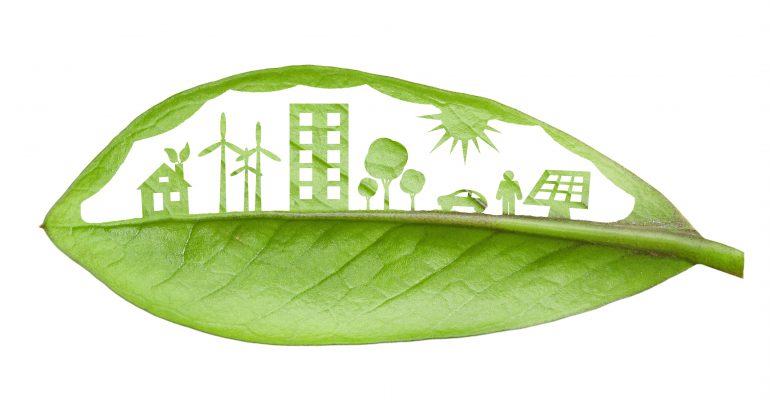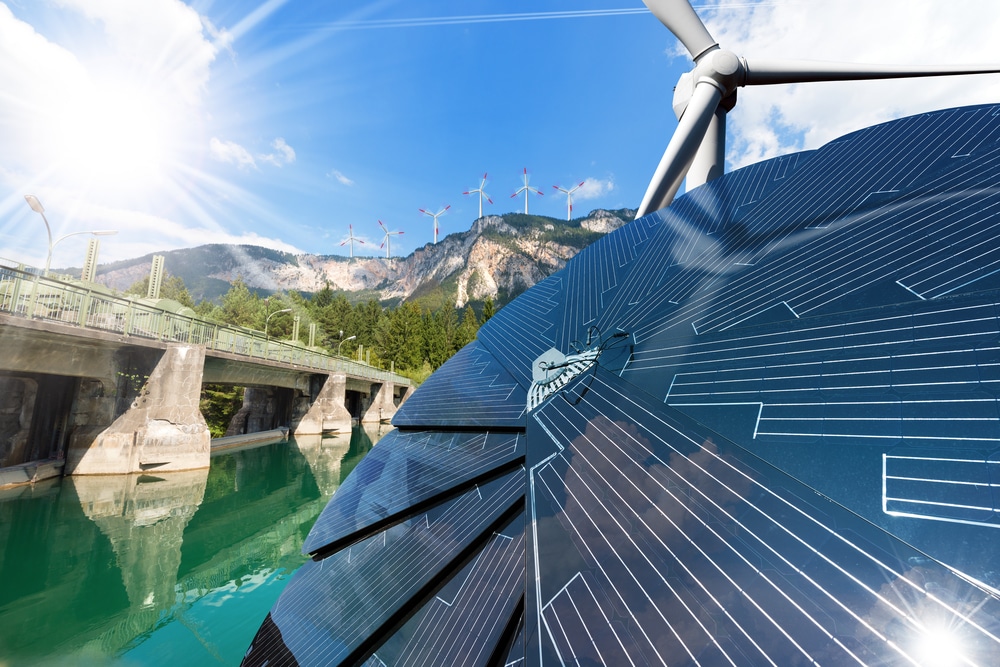Each and every day, the threat from the current state of our world’s climate grows more urgent. Understanding the facts about renewable energy is crucial as too many people have a cavalier attitude towards climate change, with some absurdly denying its existence and others simply not caring. Whatever the reason, things need to change.
Renewable energy is in motion to be the change.
Renewable energy is set to be the change we need. The main challenge is not only informing the public about the dire need to break away from our reliance on fossil fuels but also finding a solution strategy and successfully executing it. Our planet’s only hope of survival is contingent on utilizing clean energy sources, and this mission is attracting waves of attention for all the right reasons.
Renewable energy is comprised of various sources, including solar power, wind energy, hydropower, biofuel, geothermal, and more. It is a cleaner source of energy that stems from natural sources, and its popularity has been steadily increasing over time. This popularity is breathing life into programs that, without clean energy futures, would ultimately leave Earth doomed.
Electricity generation from renewable energy sources is key to reducing greenhouse gas emissions. Not many people are fully aware of the amazing benefits of renewable energy, so the purpose of this post is to shine more light on facts about renewable energy, along with some statistics and highlights. Let’s dive in.
The facts about renewable energy and how it’s changing the world
Fast adoption is happening in Europe.
Since 1997, the United Nations has been working on increasing the adoption of renewable energy. The goal was for it to become 12% of the total energy consumption of the entire EU by the year 2010. Member States were required to create and submit action plans regarding their actions to increase their renewable energy usage.
Today, different Member States have significantly increased their consumption of renewable energy, reducing carbon emissions and boosting renewable power generation. According to The European Commission, Germany’s net generated electricity from renewable sources reached 40.8% in 2023. Italy’s renewable energy consumption covered 22% of its total energy usage in 2023. In Portugal, 83.6% of all electricity consumption came from renewable sources in 2023. Offshore wind farms have been particularly instrumental in these advancements.
More countries are joining the cause and increasing their renewable energy usage. For example, Ireland, Denmark, and Britain are all expected to get 40% of their energy from renewable energy sources by 2025, contributing to cleaner energy futures and further reducing greenhouse gas emissions.
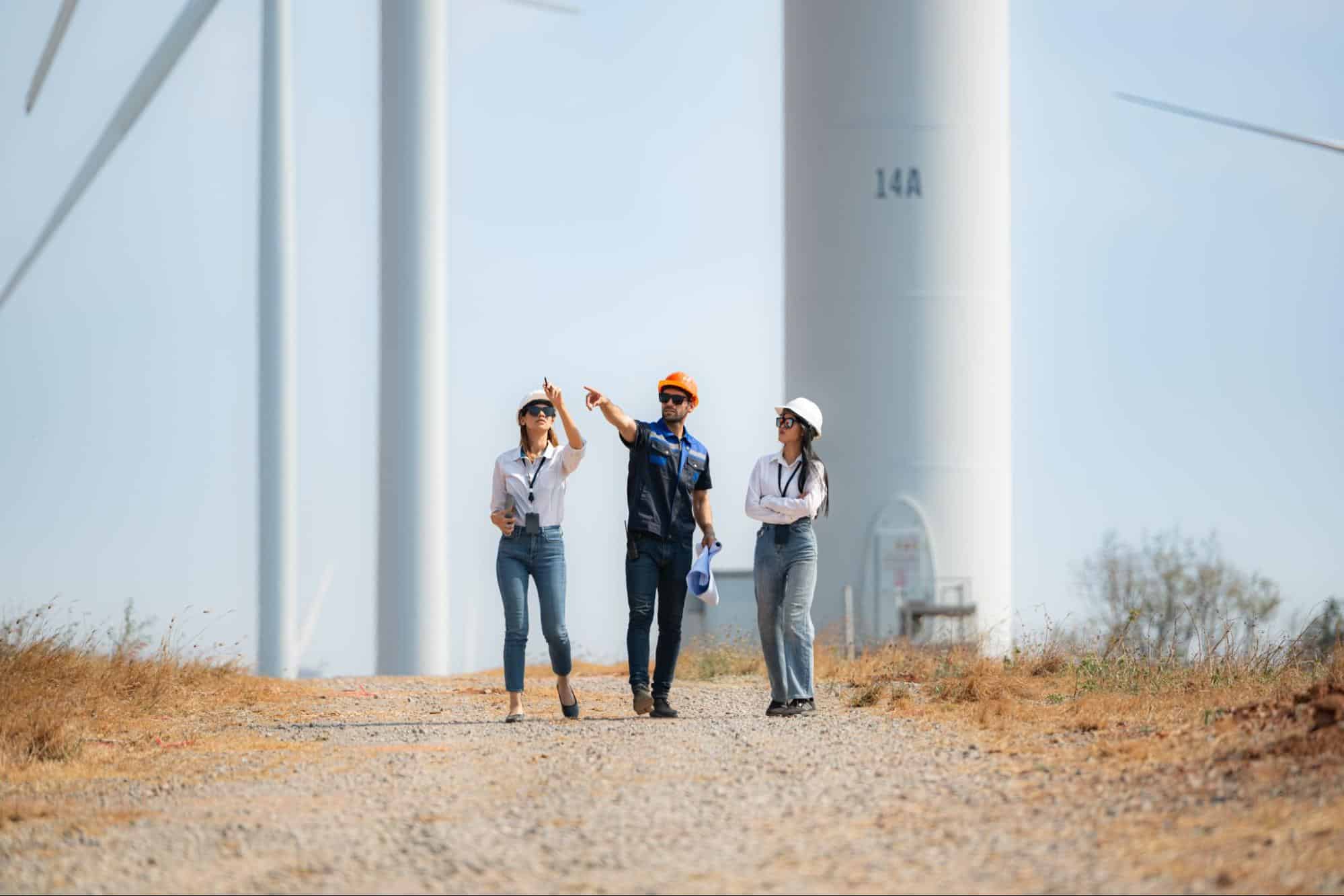
China is leading in wind power.
China, which built two windmills a day in 2014, continues to lead the world in utilizing wind power, with the United States coming in a distant second. With its vast coastline, China has abundant wind power resources, which it leverages effectively. By 2024, China’s wind power generation capacity has soared to 350 GW, producing over 100 TWh of renewable electricity in March alone—a record for any single country. China’s goal is to reach a wind capacity of 600 GW by 2030. Despite challenges, such as the distance between high-potential areas like Gansu and industrial centers, China’s renewable electricity generation is crucial for reducing carbon emissions and meeting its annual electricity demand. Offshore wind farms also play a significant role in China’s action for climate change, ensuring a clean electricity future.
China’s aggressive expansion in wind power not only demonstrates its commitment to renewable energy but also highlights its strategic approach to reducing reliance on fossil fuels. This shift is essential for mitigating climate change and promoting sustainable development. As more regions within China develop their wind power infrastructure, the country continues to set new records in clean electricity generation, solidifying its position as a global leader in renewable energy.
The advancements in wind power are part of China’s broader strategy to combat climate change and support global efforts to transition to a low-carbon economy. By investing heavily in renewable power, China is not only addressing its own energy needs but also contributing to international goals for carbon reduction and environmental sustainability. As a result, China’s leadership in wind power serves as a model for other nations aiming to enhance their renewable energy capabilities and take meaningful action for climate change.
Solar power getting to the masses.
Solar power, whose prices continue to drop as technology advances, is expected to double in global demand through 2024. By 2050, solar power is likely to become the world’s main source of energy, predicted to supply 27% of global electricity. The affordability and efficiency of solar panels have significantly improved, making solar energy more accessible worldwide.
For a long time, Europe was the primary region to utilize solar power as one of its sources of electricity. However, over the years, many other countries have also developed extensive solar power infrastructure, including India, Israel, Canada, Japan, China, Australia, Mexico, South Africa, South Korea, and Thailand. As of 2024, China leads in solar capacity, with over 300 GW installed, while the United States follows closely with substantial growth in residential and commercial solar installations. Europe remains a strong player, with Germany and Spain making significant contributions to the continent’s solar capacity.
The global shift towards solar power is driven by its potential to reduce greenhouse gas emissions and its role in creating a sustainable energy future. Countries are increasingly investing in solar technologies to meet their renewable energy targets and combat climate change. This widespread adoption of solar power not only supports environmental goals but also fosters economic growth by creating jobs in the renewable energy sector.
As solar power continues to expand, it plays a crucial role in the global transition to clean energy. The advancements in solar technology and the declining costs are encouraging more nations to embrace solar energy, ensuring a brighter and more sustainable future for the planet.
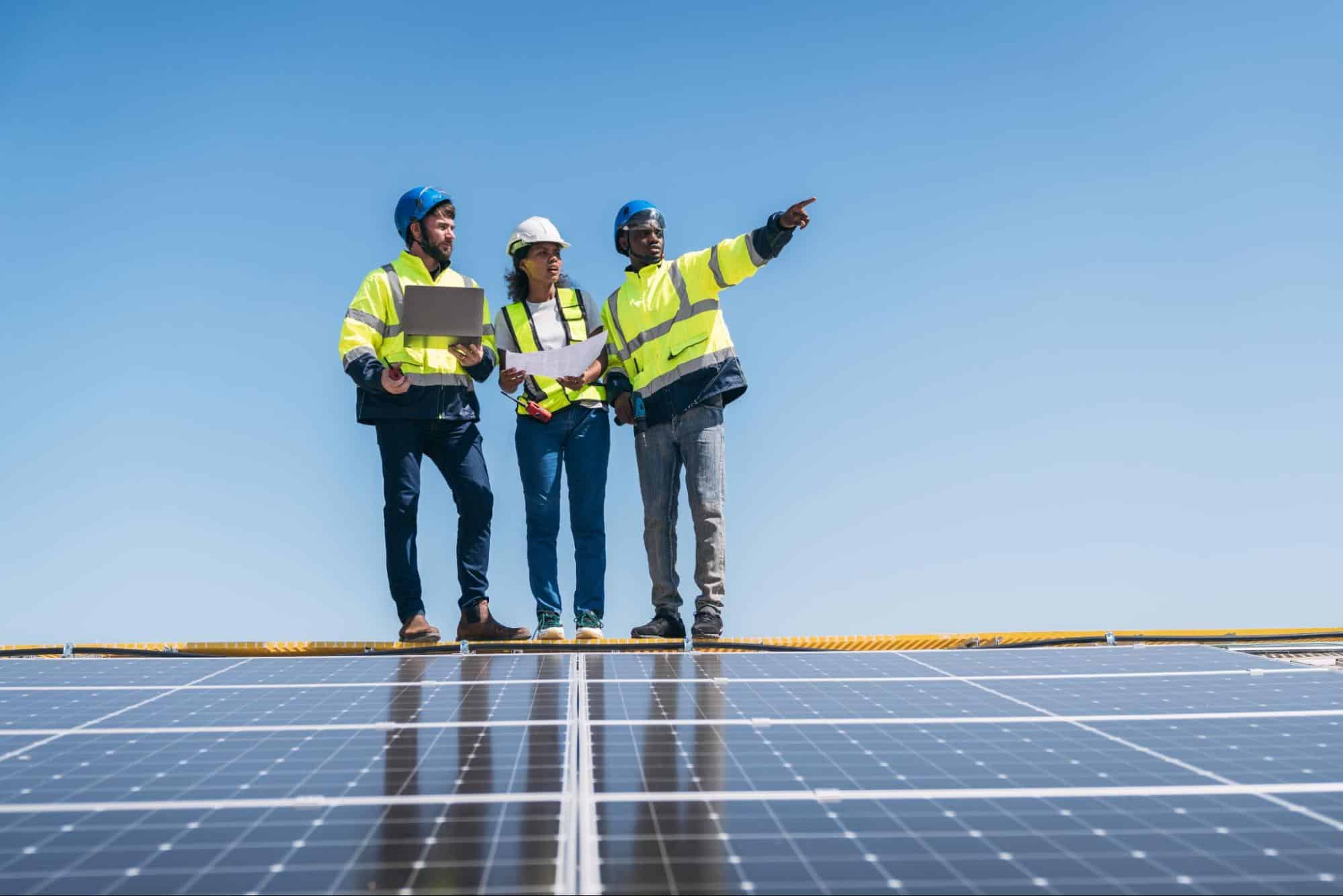
Oil billionaires are selling assets.
The Rockefeller family, who made their money in oil (fossil fuels), began to sell their investments in oil and started to move towards clean energy in 2014.
A number of powerful businessmen are working and investing in renewable energy; here are some of the ones who have truly joined the cause:
Michael Bloomberg, the 7th richest person in the United States, donated $30 million dollars supporting Sierra Club‘s goal of eliminating half of coal plants in the country by the year 2017.
Elon Musk, co-founder and CEO of Tesla who manufactures full electric cars and energy storage systems, has brought rooftop solar to the mass market.
Richard Branson, who made his fortune through the different businesses of the “Virgin” brand, is a member of the Breakthrough Energy Coalition. This organization pressures rich countries to double their funding for energy research.
Coal use is diminishing.
In the year 2024, coal consumption is experiencing significant changes. Thanks to the rise in the use of wind and solar power, as well as China’s shift away from heavy industry, global coal demand is expected to decline. Surprisingly, coal consumption had been increasing by 1.9% per year from 2005 to 2015. However, by 2023, global coal demand will rise by 1.4%, but it is projected to fall by 2.3% by 2026 due to the expansion of renewable energy production.
In the United States, coal usage dropped by nearly 20% in 2023. Meanwhile, China, responsible for 50% of the total coal burned worldwide annually, saw its coal demand rise by 5% in 2023 due to increased electricity demand and weak hydropower output. However, Chinese coal demand is expected to decline and plateau through 2026, driven by the expansion of alternative energy sources.
This shift highlights the growing importance of renewable energy sources as a viable alternative to coal. The global trend towards cleaner energy is essential for reducing greenhouse gas emissions and fostering a sustainable energy future.
Solar panel users are already benefiting.
Adding solar panels can help save around $100 a month in many states, which translates to $35,000 in twenty years. Another benefit is the increase in home value. According to the National Renewable Energy Laboratory (NREL), homes with solar panels sell 20% faster and for more money than homes without this energy source.
An important benefit of installing solar panels is their reliability. One can calculate how much electricity will be generated for at least the next twenty years and at what price, making it easier for families to budget annually. Solar projects also benefit from tax credits, making solar power generation more affordable.
California, in particular, shows significant savings. As a conservative estimate, California residents could save around $78,500 over two decades. The popularity of solar-powered homes continues to grow as more homeowners recognize the long-term financial and environmental benefits of solar power production.
An important benefit that comes with the installation of solar panels is its reliability.
One can calculate how much electricity will be generated for at least the next twenty year, and at what price, which makes it easier for the heads of the family to calculate their annual budget.
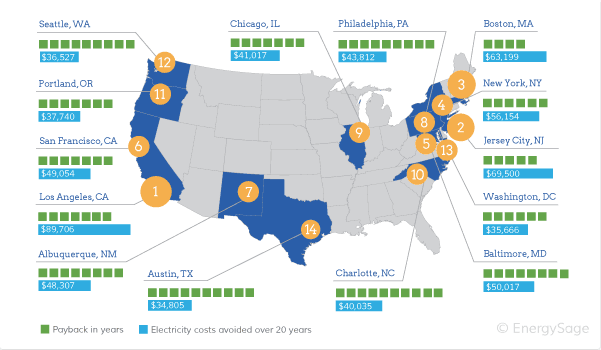
(Image Credit: Energysage)
Solar energy job growth outpacing coal.
Solar energy jobs are expanding 12 times faster than the US economy. The Energy and Employment Report from the US Department of Energy states that the solar industry now employs more people than coal, oil, and gas combined. According to the Interstate Renewable Energy Council (IREC), approximately 255,037 people were employed in the solar energy field in 2022. In contrast, coal, gas, and oil power combined employed slightly more than 187,000.
This rapid growth in solar jobs is driven by increased investments in solar projects, advancements in solar power generation technologies, and supportive government policies, including tax credits for renewable energy production. As the demand for clean energy continues to rise, the solar industry is expected to remain a significant source of job creation, contributing to economic growth and the transition to a more sustainable energy future.
Wind turbines provide more power than non-renewable energy.
First, let’s explain how a wind turbine works. It is basically the opposite of a fan. While fans use electricity to turn and make wind, wind turbines use wind to make electricity. Wind turbines come in a wide variety of sizes, some as large as a football field and as tall as a 20-story building. A single wind turbine can generate power for 1,500 homes for a year, produce 250 million cups of coffee, or run an average computer for over 2,500 years.
However, there are some environmental issues associated with wind power. Although they have a much lower environmental impact compared to fossil fuel energy sources, wind turbines produce noise that can be considered sonic pollution and have killed numerous birds and bats that fly into the blades. Additionally, as seen in China, areas with high wind energy potential are often far from cities with the highest electricity demand, making wind power more suitable for agricultural regions needing energy for farming purposes.
According to the Global Wind Energy Council’s 2024 report, the global wind industry installed a record 117 GW of new capacity in 2023, reflecting a 50% year-on-year increase. This surge is driven by increased political ambition and the adoption of targets to triple renewable energy by 2030.
Funding is coming from the top.
The World Bank is providing substantial support to India’s renewable energy program, committing $100 million in funding. According to recent World Bank data, 675 million people still lack access to electricity, and 2.3 billion people rely on polluting fuels like wood, charcoal, and coal for cooking and heating. The World Bank has invested around $28 billion in energy efficiency and renewable energy projects since 2010. This funding aims to boost renewable energy production and provide a sustainable alternative to coal, supporting global efforts to reduce carbon emissions and promote clean energy.
The biggest corporations are implementing renewable energy
There is a massive goal that the world is aiming for, which is to be 100% reliant on natural resources for our energy.
Many major corporations have already implemented strategies that are geared toward achieving this immensely important task.
- Walmart: The single largest producer of renewable energy
- Google: Directly invested a billion dollars in wind farms.
- Apple: Powers it’s data centers with clean energy
Empower Your Future with Renewable Energy Education
These facts about renewable energy not only highlight the immense potential of natural resources but also their benefits for the planet and the economy. Renewable energy creates millions of jobs, fosters international cooperation, and promises a sustainable future. From wind energy to hydroelectric dams and solar panels, the transition to renewable resources is vital.
Everglades University is leading this change by offering a Bachelor of Science Degree with a major in Alternative and Renewable Energy Management. This program equips passionate individuals with the knowledge and skills to drive the renewable energy revolution. The curriculum includes:
- Nuclear Energy
- Wind Energy
- Geothermal Energy
- Hydroelectric Energy
Our planet’s future depends on our shift to renewable energy. Join Everglades University to be at the forefront of this critical transition. Enroll today to make a meaningful impact on the world.



